- A free-wheeling
conversation with Mihir Bhattacharjee, Vikshit Bharat Ambassador and native of
Tripura on the problems affecting tourism in Tripura and how PR can help change
perceptions when preceded by preparations on the ground.
Tripura - the last virgin and unexplored Shangri-La of India is unfortunately lagging behind when it comes to Tourism, but the vital role that PR can play in promoting tourism in India’s North East can’t be denied. North East India’s inherent tourism potential and the reasons why the region has not been able to flourish in spite of its rich and diverse attractions is a matter worth pondering. PR has a lot to offer in resurrecting the tourism industry of Tripura and the North Eastern states of India and bring this region at par with mainland India.
I myself was born and brought up in
Assam so I am familiar with the geography, culture and heritage of this
fascinating region. Yet, Tripura, due to its remoteness and being a long
neglected state never presented me with opportunities. Thanks to Mr.Mihir
Bhattacharjee (MB), an ex-armed forces personnel (BSF), I am exposed me to this
unexplored state.
Below, are the thoughts from a man who has been burning the midnight’s oil for the betterment of Tripura, his home state. It is looking for today’s discerning world traveller to come and discover the hidden gems.
Conversation
with Mihir Bhattacharjee, an Ex- BSF armed forces personnel and a native of
Tripura.
Q: As a much travelled
armed forces personnel, you have had the privilege of being posted in different
regions of India and have seen how states like Rajasthan and Goa have prospered
through Tourism. What are your views about Tripura?
MB: Public Relations or PR is a powerful tool when it comes to “branding”, and hailing from an armed forces background has meant
that I have had quality exposure by way of being posted on tough assignments. Being
a Rastrawadi/Nationalist campaigner, I am definitely in favour of a well laid
out PR plan for resurrecting the image of Tripura Tourism at national and international
levels.
Tripura is one of India’s last natural, unspoilt destination. This region is renowned for its pristine splendor, undulating hills, valleys and myriad streams that course through it.
Q: What is Tripura’s and the North East of India’s unique selling point?
MB: In many ways Tripura & the North East is quite unlike the rest of India. It is the chief tribal belt of India with a great number of tribes who speak many different languages and dialects for e.g. in Arunachal Pradesh alone over 50 distinct languages are spoken! In many ways these tribal people are similar to the hill tribes found at the eastern end of the Himalayas, which extends from India through Myanmar and Thailand into Laos.
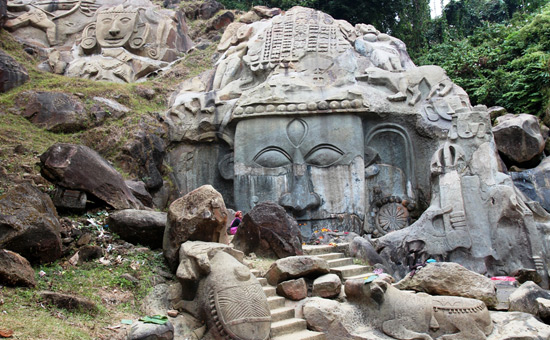 Rock-cut work at Unakoti is a wonder.
Rock-cut work at Unakoti is a wonder.
Q: You have all along been
laying stress on PR as a tool to resurrect Tourism in the North Eastern states
of India. Why is Public Relations so important?
MB: In the case of North East India’s tourism industry, it is a case of utter negligence on the part of the previous dispensations and ignorance of the people about potential of tourism and its benefits. There seemed to be a complete lack of confidence in the tourism assets that the region possessed in abundance on the part of the administration and the people in general.
However, during the last ten odd years the entire North Eastern region is witnessing unprecedented development in every sphere. The Prime Minister refers to the North Eastern region as “Asthalaxmi.”
What is basically required is a will to
excel and succeed in spite of all odds. PR is a tool that can effectively
reposition the North East of India as a preferred tourist destination. PR in
tourism is oriented towards creating and maintaining an ambience whereby the tourists
is convinced of the benefits of visiting the concerned destination.
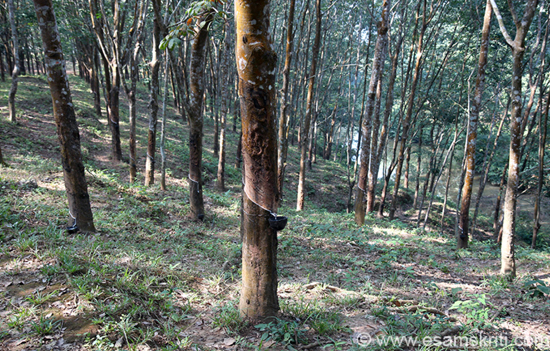 Rubber-plantations in India in Agrartala. How it is grown might interest students.
Rubber-plantations in India in Agrartala. How it is grown might interest students.
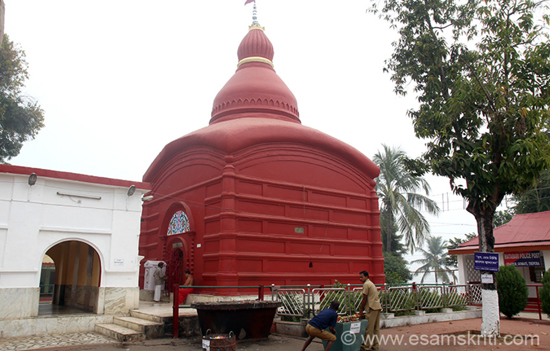 Shakti-Peeth Tripura Sundari is a few hours’s drive form Agartala.
Shakti-Peeth Tripura Sundari is a few hours’s drive form Agartala.
Q: In case of North East
India, what are the major hindrances that the Tourism industry is faced with?
MB - In
case of North East India, the major lacunas that emerge are Adverse political
Events, Wrong public perception of tourism, Inadequate and improper portrayal
of North East as a destination and the role of media is underutilized.
Let us consider each of the problems at
length and suggest PR solutions.
4 Mr Mihir Bhattacharjee, Vikshit Bharat Ambassador and native
of Tripura.
1.
Adverse Political Events
MB - The North East of India has always been a politically volatile region. There are law and order problems but terrorism that was eating into Northeast India’s economy, is mostly history. The situation today is that most of states have stable governments and the situation is fast improving. This negative image of the region can be changed by incorporating PR techniques.
Tourism in fact is a vehicle for
national and international understanding and this fact should be highlighted by
the media.
When people realize that Northeast India
consist of seven states that are spread over a large geographical area, a law
and order problem in say Manipur, will not affect the situation in Tripura or
Arunachal Pradesh.
2. Wrong Public Perception of Tourism
MB - The
general public, with the exception of a knowledgeable few, have not realized the
fact that tourism can be an industry, a profitable one without smoke, having
scope of employment generation & increase foreign exchange earnings.
The economic and social benefits of
tourism should be made known to the public so that they are made aware of the
significance of tourism. The role of PR is vital in bringing about this
awareness. The intelligentsia of the region should be persuaded and roped into
the campaign towards generating awareness. Also, well known personalities from
the world of cinema, art and music should be persuaded to play a leading role
in this awareness drive.
3.
Inadequate and Improper Portrayal of North East as a Destination
MB - There
have been no clear-cut policies as to how the North East of India should be positioned
as a tourist destination. Some call it a Tribal (Cultural) destination while others
say it is a Wildlife one. The role of PR here would be to highlight and project
the North East as a destination in a very concise, precise and specific way.
To my mind the most sensible PR option
would be to tag and label the Northeast region as an “Active Holiday or Special interest Tourist Destination” This is because of the fact that in
case of Active or Special Interest Tourism what the tourists demand is not
luxury and high quality products and services, but real experiences. The demand
invariably is for pleasant surroundings, usually at reasonable price, which the
North East of India has in abundance. This strategy calls for less of
investment in promotions and more of tourist flow.
Mihir’s formula is simple- “The essential ingredient of this new form of Tourism package is the organization of recreation, which alone can enrich the Tourism experience by allowing greater integration with the destination visited and fuller involvement in social and cultural life of the holiday destination.
And in case of Northeast India, the PR strategy that is to be advocated would be to get the tourists involved and give them the scope of greater inter-mingling with the fascinating tribal culture of the region so that they can get a feel of their exotic culture and tradition, much the same way as the Australian Tourism industry does vis-à-vis the Aborigines and New Zealand with the Maori tribe.”
This mingling
happens, in a limited way, in the Hornbill Festival at Kohima that starts on
December 1 every year. To see festival album click
The concept of
Home Stays is popular in Kohima and Tawang. It needs to become so in all parts
of the Northeast, atleast in state capitals.
4.
The Role of Media is Underutilized
MB - Tripura & the Northeast of India is one region where commercialization has not taken place, at least not in the tourism industry. There is also less of consumerism as compared to the other places of mainland India. Its culture too has remained relatively uncontaminated and pristine. All this has meant that the various mass media in the form of TV, radio and the press – both print and electronic are not that competitive. Also, there is less of professionalism and more of emotionalism.
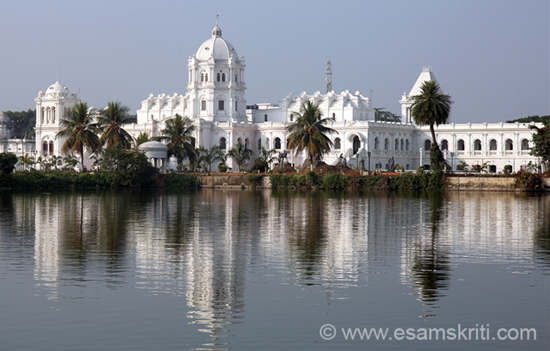 Ujjayanta Palace in Agartala is very impressive. It is a Museum today.
Ujjayanta Palace in Agartala is very impressive. It is a Museum today.
In case of Northeast India, the use of
mass media to propagate and spread tourism awareness as also the inherent
tourism potential of this region has not been fully explored. Whatever little
use has been made has been mostly unplanned and bereft of coordination that has
resulted in lack of impact as far as the general public is concerned.
MB says, The PR strategy in this regard would be to use the mass media with more regularity and the information has to be more trustworthy and credible. The use of the Internet as a medium of publicity has a special relevance in the context of today’s connected world. Rising demand of tourists and the ever-increasing supply of new tourist destinations characterize the present day situation in the world travel market. It’s a competitive world out there and the best way to make one’s presence felt is by launching Northeast aggressively on the Web.”
For the mandarins of Tripura’s fledgling Tourism industry, Mihir’s suggestion is visionary and farsighted. He proposes the development of a web enabled Visitor Management System (VMS) for not just Tripura but the North East of India as a whole. He is of the opinion that this can be developed separately or can be integrated with the Ministry of Tourism’s portal.
The main objectives of this web enabled VMS would be to make available a database of all information pertaining to the Northeast’s tourist circuits, a database of tour operators-transportation facilities-accommodation and other tourist infrastructure (services and facilities) to the interested/potential tourists and information seekers, e-postcards, etc.
The
VMS would also be a helpful tool to monitor the visitor management by
systematic collection of data. Over the longer run, the system could take the
shape of a portal through which tourists can book the lodges/ hotels as well as
pre-book their entry to the tourist circuit.
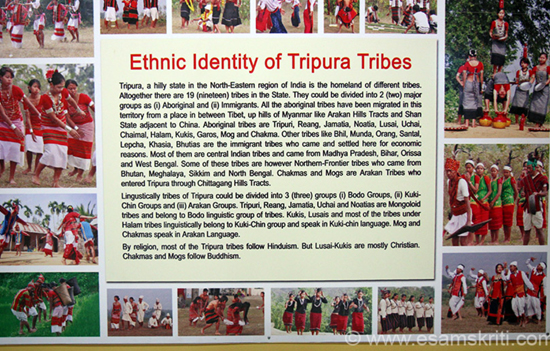 Agartala has an impressive Tribal Museum.
Agartala has an impressive Tribal Museum.
The
Future
MB - There is no doubt that the entire North East region’s tourism industry is growing and evolving. There will definitely come a time when the whole of North East India will reverberate with global tourists.
If innovative PR solutions like those mentioned above are implemented in letter and spirit – a tourism revolution is on the cards and it could be a “Game Changer” for not just Tripura, but the entire North East.
But how soon this turnaround comes
depends entirely on the pace of progressive reforms being practically applied
at the grassroots level.
To read all
articles by author
To see albums on each Northeast state
1. Assam
2. Tripura
3. Arunachal
Pradesh
4. Manipur
5. Nagaland
6. Meghalaya
7. On Mizoram unfortunately have no
album on site.
On Sikkim read travelogue The Best of 5
days in Sikkim and Albums